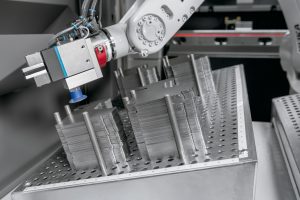 When production demands are high for fabrication shops, automating bending operations provides much-needed flexibility. With the introduction of high speed Fiber lasers, productivity has increased. As a result, the demand for additional bending capacity has also increased.
When production demands are high for fabrication shops, automating bending operations provides much-needed flexibility. With the introduction of high speed Fiber lasers, productivity has increased. As a result, the demand for additional bending capacity has also increased.
Offline programming capabilities are one solution for maintaining the pace, however, in most cases there is still the need for additional increases in bending capacity. One of the best opportunities available for gaining this additional press brake bending capacity is by combining the efficiency of automation with the ability to process orders in off-shifts.
Automating for Larger Lot Sizes
For most small lot sizes, automation does not make sense because the set-up time is where the majority of the time is spent on most jobs. For small lot sizes, it makes sense for operators to complete those jobs manually, saving the longer run jobs for automated press brake systems. The new mobile bending automation systems allow the press brake to be operated manually during working shifts, and become completely automated with the quick addition of a mobile robot bending cell in the off-shifts, thus providing the ultimate flexibility with bending operations.
Automating for Large Parts and Safety
For larger lot sizes, the addition of a robot to perform bending operations is essential, especially when the parts are large and require a great deal of handling for bending. This need is highly evident when multiple operators are required to handle the parts over long periods of time. Not only does the job now require double the labor, but production efficiency over the course of a working shift will decrease as fatigue begins to set in. Also, there is an increased risk of injury when handling large parts for long periods of time.
Automating for Maintaining the Pace
Press brake automation is available in a range of machine sizes, and equally, for many different applications. Many of the larger lot sizes comprised of bending lighter gauge parts require bending automation for two distinct reasons: one is the size of the job; the second is the necessity to keep the pace with today’s new high-speed press brakes. A bending speed of one inch per second is not unusual for these high performance press brakes, not to mention the level and endurance required from the operator is also demanding.
Opportunity and Flexibility
The ability of automated bending systems to operate in off-shifts provides the flexibility to operate a press brake in unmanned shifts and fully utilize the additional bending capacity that is created with press brake automation. With today’s interconnected machines providing real-time production data and the ability of web cameras to visualize the production also in real-time, it is easy to manage these systems, even during a long weekend. Real-time machine production data can forecast when the materials will need to be changed out, so new materials can be moved into position, enabling the automated press brake bending systems to continue operating in a timely manner.
Learn more about today’s modern press brakes HERE.
Learn more about mobile bending automation HERE.
By Frank Arteaga, Head of Product Marketing, NAFTA Region Bystronic Inc., Elgin, IL – Voice.bystronic@bystronic.com
